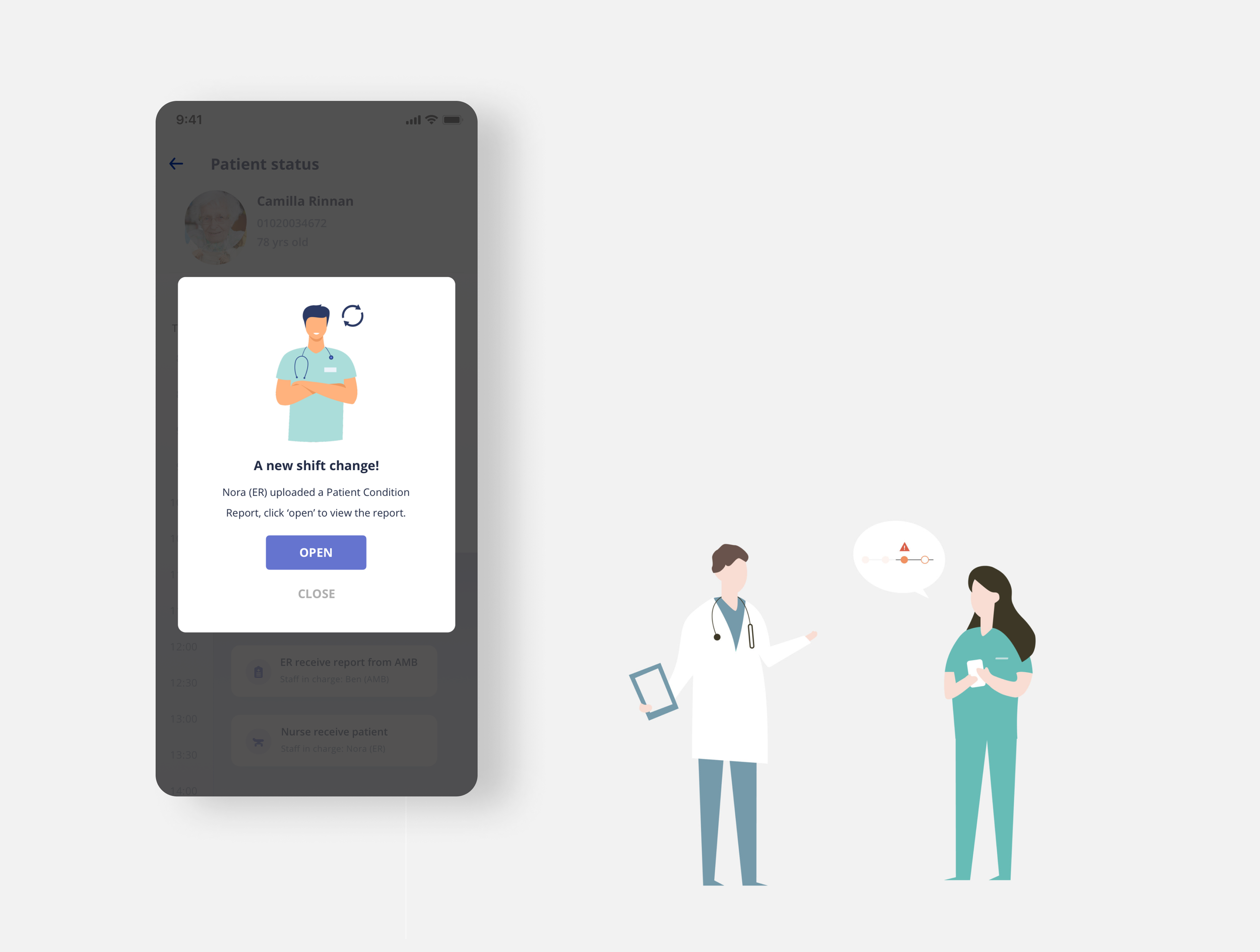
Going Orange
Tracking hip fracture patient journey to reduce waiting time for surgery.
Overview
Elderly hip fracture patients will enter a fast-tracked process to reduce waiting time for surgery, but currently there is no way to ensure that all staff are aware of and participate in the process, patient’s precious time get wasted.
Client
Akershus University Hospital
Team
1 Visual & service designer (me)
1 Design researcher
My role
User Research
Concept Proposal
UI UX design
Branding design
Duration
4 weeks
Tool
Illustrator
Keynote
Paper prototype
Going Orange is a set of collaborative tools designed for Akershus medical staff. By visualizing the patient journey, it creates visual reminders for existing staff throughout the fast-track process and serves as the entry point for new staff to enter the process; improving the transparency of patient information for the purpose of improving the efficiency of medical staff.
OPPORTUNITY
How can we create sustained awareness of the Fast-Track process for new and existing Fast-Track actors?
The solution
“Making the Fast Track visible to everyone”
Digitalize patient information, and promote efficient collaboration of medical staff
Prioritize tasks to save more time for emergency patients
Raise awareness of existing and new healthcare workers and guide participation in the tracking process
Professionalizing the medical treatment process to improve the professionalism of the hospital
Save manpower and material resources and save costs for the hospital
Process
BACKGROUND
Better care for elderly hip fracture patients
Statistics from CDC show that over 300,000 older people (those 65 and older) are hospitalized for hip fractures each year, and up to 50% of patients with a hip fracture die within six months.
The Akershus University Hospital is a Norwegian public university hospital in Oslo. The initial brief of this project is to provide better patient care for the elderly with hip fractures.
RESEARCH
What is the current patient journey?
In order to understand the whole patient journey in Akershus hospital, we had multiple interviews with some staff working in the hospital and some workers at municipalities and mapped out the entire patient journey.
SCOPING
The Fast-Track process
Patients over 65 years old with suspected hip fracture have to wait for a long time for examinations, X rays, and surgery. They will suffer from severe pain, infection, and longer hospital stays.
To "fast-track" care for hip fracture patients, the ambulance nurse starts the preoperative procedure (usually performed in the accident and emergency department [A&E]) and transfers patients directly to radiology, bypassing A&E. The fast-track care for hip fracture patients can minimize complications, heighten priorities, and decrease the overall length of care.
FINDINGS
Pain points
Not everyone is aware of the
Fast Track
High staff turnover makes it hard to keep everyone informed
Procedures are sometimes not followed by those who are aware
A shorter time of waiting for surgery can help patient get recovered faster than usual
-orthopedics doctor
Final brief
How can we create sustained awareness of the Fast-Track process for new and existing Fast-Track actors?
IDEATION
What if information about the Fast Track travelled with the patient?
What if we made the Fast Track visible in order to create visual reminders for existing staff and a point of entry into the process for new staff, and paired these reminders with resources that could guide them through the process?
What item is travelled with the patient?
I chose to focus on the patient's wristband because the gown and pillow idea is not feasible due to hospital regulations.
FINAL DESIGN
Going orange
Going Orange is a set of collaborative tools designed for Akershus medical staff. By visualizing the patient journey, it creates visual reminders for existing staff throughout the fast-track process and serves as the entry point for new staff to enter the process.
Jonas is a 77 year old man. One day, he accidentally fell at home and was not able to move his body.
01
Fortunately, his son found him and called an ambulance. They went to his house immediately to help him.
02
In the ambulance, the staff evaluated Jonas’s pain level and decided to put a wristband on him, and scanned the barcode. This means this is an emergency case and the Fast Track procedure will start now.
03
All the hospital staff will be informed that Jonas is on the Fast Track. While the ambulance is on its way, the hospital is starting to prepare arrange a bed and refer X-ray for the patient.
User interface
Design Value
For patientsHelp patients reduce recovery time, achieve better care
04
How it works?
Jonas successfully arrived at the hospital and now every staff would know he is in the Fast Track process by seeing his wristband and can keep tracking him.
Anne is nursing today. When she check the recent process, she found that the process has been blocked for some reason. She found the contact information for the responsible nurse.
For hospital staffImprove work efficiency, minimize mistakes
05
When there is a turnover staff forgot to inform the following nurse to keep up the process, the app will show a warning page for medical staff.
06
For hospitalImprove the quality of patient care, build a better reputation




















